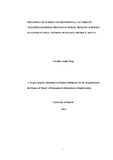| dc.description.abstract | The main purpose of this study was to determine the influence of
school environmental factors on the teaching-learning process in public
primary schools in Lower Nyokal division Homabay district, Kenya.
School environmental factors refer to those aspects within the school
surrounding that may influence the process of teaching and learning. The
study sought to fulfill the following objectives: to examine the effect of
physical facilities on the teaching-learning process; to assess how
sufficiency of instructional materials can promote the teaching-learning
process; to explore how class size promotes teaching-learning process and
to determine how school location affects the process of teaching-learning
in public primary schools. The study was guided by the Systems Theory
of organizations. The study adopted descriptive survey design.
Questionnaires were used to gather information from teachers and head
teachers while focus group discussion guide was used with the pupils. The
findings of the study revealed that schools have inadequate physical
facilities, with some being totally unavailable. Instructional materials are
generally insufficient. Majority of the schools had large classes though
most teachers prefer small classes. Lastly the teachers prefer working in
accessible schools with proximity to adequate social facilities and
infrastructure. The study concluded that inadequacy of physical facilities
in schools has been found to influence teaching-learning process. In
addition, there is general insufficiency of instructional materials in
schools has also been found to greatly influence the teaching-learning
process. The size of class has been found to greatly influence the teachinglearning
process small classes are mostly preferred by most teachers and
even pupils yet they have large classes. On school location, the schools in
the rural areas are least preferred. Non-cosmopolitanism has also greatly
affected the rural schools as the communities still have influence in the
administration and operations of the schools.
The study recommended that to improve teaching-learning process in the
division, school heads should strive to provide physical facilities and
instructional materials in schools. Large classes should be broken into two
or more streams to make them manageable. Parents and communities
living around the school should be sensitized on the importance of
supporting school programs and be encouraged to organize fundraisers to
put up physical facilities and procure instructional materials in schools.
They should also be encouraged to buy revision books for their children.
Further research may be done on influence of school environment on
KCPE performance in public primary schools, influence of school motto
and other school symbols on academic performance and how teacher
characteristics influences pupils academic performance. | en_US |

